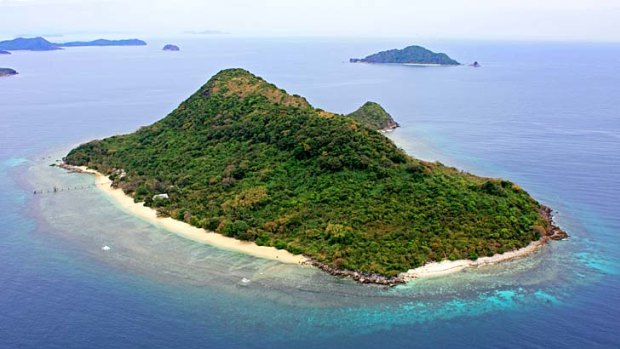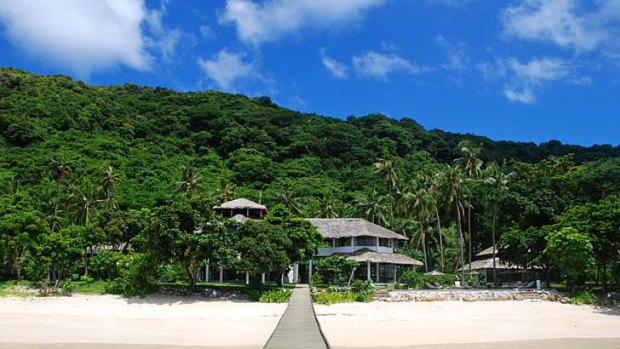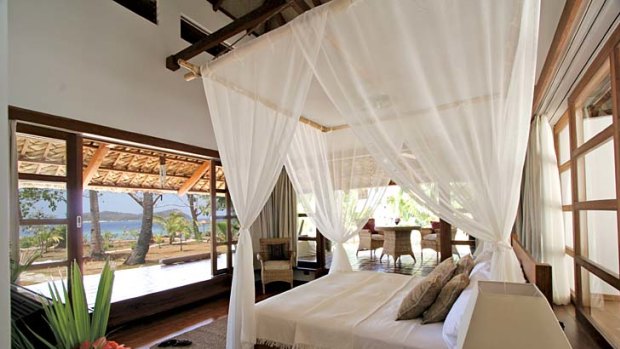
Private pleasures ... Ariara Island.
Tom Adair explores a private island in a remote archipelago where the diving is world class.
On Ariara, a conical speck of jungle-green in the Sulu Sea - one of hundreds of islands scattered south-west of Manila - I'm wilting.
We could have chosen to fly from Manila directly by helicopter or float plane. Instead, we've taken a short flight to the island of Busuanga, then a trimaran from the port of Coron. This would be a chance to doze but these beautiful, scarcely populated islands of the Calamian group keep me riveted.

The jetty to the private resort.
Four hours later we see Ariara's ribbon of beach, its row of thatched dwellings, newly built. We're among the first guests to plant a footprint in the sand.
The island's owner, Charles McCulloch, stands at the end of the jetty to greet us. A property developer from Britain, McCulloch fell for this corner of the archipelago six years ago and dreamt of his own Shangri-la.
Since then, McCulloch and his wife, Carrie, working with Filipino architect Jorge Yulo, have designed and built a tiny private resort comprising four beach bungalows and four jungle villas. Their food supplies are mostly grown on the island. Local fishermen bring the catch daily; other supplies arrive twice a week by boat from Busuanga.

One of the bungalows.
McCulloch says he fell in love with "the undiscovered sense of paradise here, with its feeling of authenticity". His private island appeals to travellers who seek to avoid the trappings (and entrapments) of resorts or hotels. You won't meet strangers here. The island is rented exclusively for up to 17 people; a getaway for a milestone birthday or reunion, or a timely dose of self-indulgence. "You are a house guest," Carrie says. "Eat when you wish. Sleep when you want to."
The central lodge, with its soaring roof of anahaw thatch, houses a lounge upholstered in Filipino fabrics and a circular dining room with a dominant mango-wood table. Flanking the lodge are thatched bungalows and villas. Mine is closest to the beach: contemporary, yet with traditional etchings and sculptures. Beneath a vaulted roof is a four-poster bed of local wood. A dragonfly buzzes the shower head. We quietly marvel at the bathtub, "carved from a single slab of marble", McCulloch says. Outside, the darkening hillside emits the insect crackle of dusk. Above us, a gecko gurgles softly.
Next morning I swing on a wicker bucket seat under a fig tree above the beach, counting islands and possibilities. A trimaran trip or diving? Fishing or snorkelling? I choose the latter, racing into the warm sea. On the bottom, loose lumps of coral roll in the current, a slipstream of fish no bigger than whitebait clusters around me, hyphens of light.
"They'll be dilis," McCulloch says over lunch, "taking shelter from bigger beasts." One of these beasts is on the table: a yellow-tail tuna served with salad and sweet potato chips. The combination of wine and fish lulls me to nap, stretched out on the deck of the trimaran.
I wake when we anchor in a bay off Linapacan, a large island to the south of Ariara. Wading through the shallows, we approach a straggle of beach huts. We're surrounded by giggling children, too young to go to school in San Miguel, the island's sole town of 3000 people, about 32 kilometres south.
There's a hill above the village and we're here to climb it for a reason. And in the leafy gloom, there it is: a ruined fortress built by Filipino slaves for Spanish masters 400 years ago. Fallen boulders and screw pines now hem it in. The fort's interior is a tangle of lianas and malapapaya trees, leaning over the battlements, recolonising the rubble.
That night by the beach at Ariara, flying foxes loop towards the reef in dimming light; a swarm of fireflies hovers near the beachfront spa-shack. The talk around the barbecue is of night dives and island wildlife - McCulloch describes the night baby turtles hatched and took off in the wrong direction, away from the sea.
The next morning Florian, the dive instructor, leads a party to a wreck dive around a World War II supply ship. I head instead into the jungle, following Joshua, one of the island's two-dozen staff, with his gleaming machete. His charm is equalled by his efficiency. I lurch, while he skips ahead, until at last we stand on the summit of the island surrounded by pitcher plants, with me gasping. Below us islands lie on a diamante sea, none of them, thus far, touched by tourism. Far away lies the scribbled wake of the little dive boat.
Later the divers describe what I've missed: angel fish, clown fish, the brilliance of coral. "This is a fabulous place to dive," one says. "A great place to learn." I play my best card: a giant water-monitor lizard seen near rocks over which I had abseiled back to base. It fails to impress.
That afternoon McCulloch and I jet-ski around the tiny neighbouring island of Inapupan. A community of perhaps 200 people lives in shacks above the beach. There is so little land, yet they build boats, catch fish and farm cashews and root vegetables. They seem formidably alive: children leaping around a basketball hoop, women scooping up runaway toddlers, men swigging beer. The pace of life here is so slow that it seems incongruous to be on a jet-ski.
That night, like every night, we dine well. Later, I sit on my verandah reading about Ferdinand Magellan, who charted a course through this archipelago in 1521, on a mission of subjugation. I consider my own trip, my fleeting contact with local people.
Two days earlier, in San Miguel, the fingers of Carmelita Fernandez, a spirit healer, had soothed the veins of my ankle in my attempt to fix an old injury. "When you go home," the translator had said, "you must buy faith healer pills." Go home?
That evening - my last - I lie and listen to my resident companion, the rooftop gecko, gulping mosquitoes. I can't sleep. At 2 o'clock, I find my torch and walk outside, where the noise of the sea drowns everything else. Could it drown my thoughts? I darken the torch, kick off my sandals and take to the sea.
Tom Adair travelled courtesy of Ariara Island
FAST FACTS
Getting there
Philippine Airlines flies to Manila from Sydney (8hr) and Melbourne (7hr) for about $1120 low-season return, including tax. Some flights from Melbourne transit through Sydney. Cebu Airlines flies from Manila to Busuanga Island; private boat transfers from the island's port, Coron, to Ariara Island cost $US600 ($560) a party, return. Helicopter transfers from Manila to Ariara (1hr 15min) cost $US3300 a person return for five people. Float plane transfers (1hr 45min) cost $US1050 a person return for three people.
Staying there
Ariara Island is available for rental from $US295 a person a night for a party of 15-17 guests. This includes exclusive occupation of the entire island, staff, all meals, two dives a person a week and use of water-sports equipment (30-metre trimaran, 10-metre speedboat, two jet-skis, dive boat, kayaks, windsurfers, water-skis, wakeboards, fishing and snorkelling gear). Drinks and fuel are not included. See ariaraisland.com.
Sign up for the Traveller Deals newsletter
Get exclusive travel deals delivered straight to your inbox. Sign up now.